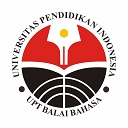Japanese Semiaspectual Forms -teshimau and -teoku as Discourse Markers
Abstract
Keywords
Full Text:
PDF (IND)References
Bybee, J., Perkins, R., & Pagliuca, W. (1994) The Evolution of Grammar: Tense, Aspect, and Modality in The Languages of The World. Chicago and London: The University of Chicago Press.
Chen, X. (陳相州). (2008). 「日本語会話データに見られる対比談話標識の使用実態」『言葉と文化 (9). pp.237-252. 名古屋大学大学院国際言語文化研究科日本言語文化専攻
Chou, Y. (張又華). (2011). 「主観的・間主観的意味の発生をめぐって : 日本語アスペクト形式「テシマウ」「チャウ」を例に」『言語科学論集』17. pp.131-142. 京都大学大学院人間・環境学研究科言語科学講https://doi.org/10.14989/155035)
Fraser, B. (2009). Topic Orientation Markers. Journal of Pragmatics, 41, 892–898.
Hanamura, H. (2014). 「日本語の雑談会話における話題転換研究の方法 :話題転換はどこで行われ、どう分類されるか」『言語文化学研究. 言語情報編』9. 大阪府立大学人間社会学部言語文化学科, pp.71-99. http://doi.org/10.24729/00002719
Hanamura, H. (2015a).「日本語の会話における話題転換研究の概観:日本語教育に生かすための研究をめざして」『言語文化学研究 言語情報編』10. 大阪府立大学人間社会学部言語文化学科. pp.65 - 102. Diakses dari https://opera.repo.nii.ac.jp/?action=repository_uri&item_id=2720&file_id=19&file_no=1
Hanamura, H. (2015b).「日本語の会話における話題転換表現:新出型・再開型・前提提示型という話題転換の型による使いわけ」『社会言語科学 』18(1), pp. 75 – 92. https://doi.org/10.19024/jajls.18.1_75
Hirose, K. (廣瀬浩三). (2012).「談話標識を巡って」. 『島根大学外国語教育センタージャーナル』(7), 1-28. 島根大学外国語教育センター.
Huang, L. (黄 麗). (2015). 『「てしまう」とその縮約形「ちゃう」の研究:評価的意味を中心に』(桜美林大学修士論文)
Isshiki, M. (一色舞子). (2011). 「日本語の補助動詞『‐てしまう』の文法化 : 主観化、間主観化を中心に」『日本研究』Vol.15. 高麗大学日本研究センター, pp.201-221. Diakses dari http://hdl.handle.net/2115/45277
Kanda, Y. (神田靖子). (2004). 「ラポール維持管理のストラテジー : 交渉場面における「格下げ表現」」『同志社大学留学生別科紀要』4号, pp.41-58. http://doi.org/10.14988/pa.2017.0000013904
Keum, J. (琴 鍾愛). (2005). 「日本語方言における談話標識の出現傾向:東京方言、大阪方言、仙台方言の比較 (Patterning of Discourse Markers in Japanese Dialects: Comparison of Tokyo, Osaka and Sendai Dialects)」『日本語の研究』第1巻2号. The Society of Japanese Linguistics. Diakses dari https://www.jstage.jst.go.jp/article/nihongonokenkyu/1/2/1_KJ00004553246/_pdf/-char/ja)
Kinsui, S. (金水敏). (2000). 「時の表現」『時・否定と取り立て』日本語の文法2. 岩波書店.
Kinsui, S. (金水敏). (2003). 「文脈的結果状態に基づく日本語助動詞の意味記述」『柴谷方良先生還暦記念論文集』(仮題: 2003 年刊行予定). Preprint. Diases dari http://www.let.osaka-.ac.jp/~kinsui/ronbun/ron03/kin03.pdf.
Kondo, Y. (近藤優美子). (2016). 「テシマッタの使用制約:なぜ『目的地に到着してしまいました』とカーナビは言わないのか」『日本語教育』16号. https://doi.org/10.20721/nihongokyoiku.164.2016_50
Kudo, M. (工藤真由美). (1995). 『アスペクト・テンス体系とテクスト:現代日本語の時間の表現』ひつじ書房.
Miyabe, M. (2018). 「シテシマウの基本的な意味とテクスト的な意味とのかかわり」『人文・自然研究』第 12 号. 一橋大学. pp.52-69. Diakses dari http://hermes-ir.lib.hit-u.ac.jp/hermes/ir/re/ 29096/jinbun0001200520.pdf.
Schiffrin, D. (1987). Discourse Markers. Cambridge: Cambridge University Press.
Spencer-Oatey, H. (2000). Culturally Speaking. London: Continuum.
Takahara, O. (高原脩). (2003). 「談話標識」『応用言語学事典』研究社. pp.280-281.
Tanaka, N. (田中奈緒美). (2015). 「話題転換時における談話標識の使用に関する日中比較」『島根大学外国語教育センタージャーナル』10巻. pp.131-141.島根大学外国語教育センター.
(https://ir.lib.shimane-u.ac.jp/files/public/ 3/31504/20170425035311836/e002010009.pdf)
Tanaka, N. (田中奈緒美). (2018). 「談話理解の視点から見た話題開始のための談話標識の分類」『日本語教育』170号.pp.130-137. 日本語教育学. Diakses dari https://www. jstage.jst.go.jp/article/nihongokyoiku/170/0/170_130/_pdf/-char/ja
Taniguchi, S. (谷口秀治). (2000). 「『~ておく』に関する一考察 -終結性を持つ用法を中心に-」『日本語教育』104号. 1-9.日本語教育学会.
Tsuji, S. (辻周吾). (2017). 「補助動詞『~ておく』に関する一考察:対人配慮の視点から」『日本学研究』第2号(2). 国際言語文化学会. pp.21-40.
Ueda, S. (植田志穂). (2017). 「テオクの性質と日本語教育における提出法」『日本語・日本文化研究』27. 大阪大学. pp.204-215. Diakses dari http://hdl.handle.net/11094/69229.
Xu, L. (許臨揚). (2015). 『認知言語学的な観点から見た日本語の「完了」アスペクトの形式』(名古屋大学博士論文)
Yamamoto, H. (山本裕子). (2005).「「~ておく」の意味機能について」『名古屋女子大学 紀要』51 (人・社) .pp.207-218.
Yang, H. (楊虹). (2005). 「中日接触場面の話題転換:
中国語母語話者に注目して」『言語文化と日本語教育』30号. お茶の水女子大学日本言語文化学研究会. Diakses dari http://purl.org/coar/resource_type/c_6501
Korpus
I-JAS International Corpus of Japanese as a Second Language. Ninjal.
Media Massa Elektronik
スポニチ (https://www.sponichi.co.jp/sports/news/ 2021/02/04/kiji/20210204s00048000572000c.html)
現代ビジネス(https://gendai.ismedia.jp/articles/-/79942? page=5) 2021—2—4
DOI: https://doi.org/10.17509/japanedu.v6i1.33543
Refbacks
- There are currently no refbacks.
Copyright (c) 2021 JAPANEDU: Jurnal Pendidikan dan Pengajaran Bahasa Jepang

This work is licensed under a Creative Commons Attribution-ShareAlike 4.0 International License.
 Published by:
Published by: Department of Japanese Language Education, Faculty of Language and Literature Education
Universitas Pendidikan Indonesia
 Online ISSN: Online ISSN:2528-5548 |

JAPANEDU: Jurnal Pendidikan dan Pengajaran Bahasa Jepang (e-ISSN:2528-5548) lisenced under a Creative Commons Attribution-ShareAlike 4.0 Internasional (CC BY-SA 4.0)


